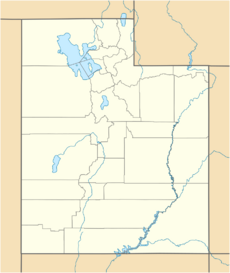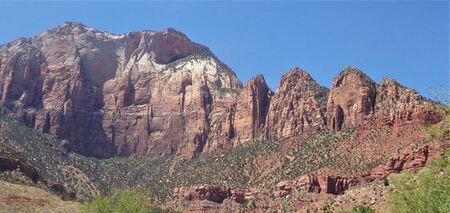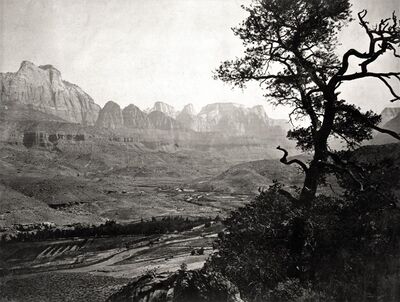Earth:Three Marys (Zion)
| Three Marys | |
|---|---|
 Southeast aspect, from Springdale | |
| Highest point | |
| Elevation | 6,420 ft (1,960 m) [1] |
| Prominence | 378 ft (115 m) [2] |
| Parent peak | The West Temple (7,810 ft)[2] |
| Isolation | 0.51 mi (0.82 km) [1] |
| Coordinates | [ ⚑ ] : 37°12′30″N 113°00′43″W / 37.2083156°N 113.0118854°W [3] |
| Geography | |
| Location | Zion National Park Washington County, Utah United States |
| Parent range | Colorado Plateau |
| Topo map | USGS Springdale West |
| Geology | |
| Type of rock | Navajo Sandstone |
| Climbing | |
| Easiest route | class 5.x climbing[1] |
Three Marys are three sandstone pillars located in Zion National Park, in Washington County of southwest Utah, United States .[3] Three Marys is situated immediately northwest of Springdale, Utah, and 1.5 mi (2.4 km) west of the park headquarters. The west peak is highest at 6,420-feet elevation, the middle peak is 6,298-feet, and the east peak is lowest, at 6,020-feet.[4] The nearest higher peak is The West Temple, 0.66 miles (1.06 km) to the west.[2] Other neighbors include The Sundial, Altar of Sacrifice, Meridian Tower, Bee Hive, Bridge Mountain, The Watchman, and Mount Kinesava. Precipitation runoff from this mountain drains into the North Fork Virgin River. This feature's name, presumably for The Three Marys, was officially adopted in 1934 by the U.S. Board on Geographic Names.[3]
Climate
Spring and fall are the most favorable seasons to visit this feature. According to the Köppen climate classification system, it is located in a Cold semi-arid climate zone, which is defined by the coldest month having an average mean temperature below 32 °F (0 °C), and at least 50% of the total annual precipitation being received during the spring and summer. This desert climate receives less than 10 inches (250 millimeters) of annual rainfall, and snowfall is generally light during the winter.[5]
References
- ↑ 1.0 1.1 1.2 "Three Marys, West - 6,420' UT". https://listsofjohn.com/peak/22198. Retrieved 2020-09-14.
- ↑ 2.0 2.1 2.2 "Three Marys-Middle Peak, Utah". http://www.peakbagger.com/peak.aspx?pid=63837.
- ↑ 3.0 3.1 3.2 U.S. Geological Survey Geographic Names Information System: Three Marys
- ↑ "Three Marys, East, Utah". http://www.peakbagger.com/peak.aspx?pid=-77931.
- ↑ "Zion National Park, Utah, USA - Monthly weather forecast and Climate data". Weather Atlas. https://www.weather-us.com/en/utah-usa/zion-national-park-climate.
See also
- Geology of the Zion and Kolob canyons area
Template:Geographic Location 2
External links
- Zion National Park National Park Service
- National Weather Service Forecast
- The Three Marys rock climbing: Mountainproject.com





